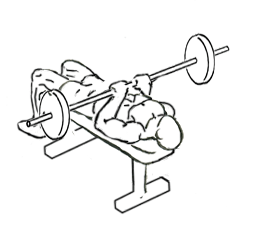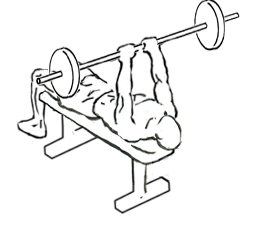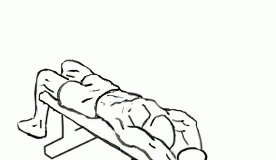Last Updated on September 30, 2022
The JM Press is a powerful and advanced exercise that targets the triceps—the muscles on the back of your arms—known for building explosive strength and muscle mass. Named after its inventor, J.M. Blakley, this movement is popular among bodybuilders and powerlifters who seek to increase arm strength and improve their bench press performance. Often referred to as the close grip barbell press, the JM Press combines elements of the skull crusher and close-grip bench press, making it one of the most effective triceps exercises when performed correctly.
Why the JM Press Is Effective
The JM Press is a hybrid exercise that bridges the gap between pressing and extension movements, directly targeting the triceps muscles. Here are several reasons why the JM Press is a staple for serious lifters:
- Isolates the Triceps: By focusing the movement primarily on the triceps, the JM Press helps build significant strength and mass in these muscles, which is crucial for overall upper body power.
- Enhances Bench Press Performance: Strong triceps are vital for a powerful bench press, especially in the lockout phase. The JM Press helps lifters develop the strength needed to drive the bar upward and complete the lift.
- Builds Explosive Power: This exercise encourages controlled but rapid movements, promoting explosive power, which is essential for athletic performance and compound lifts.
- Versatile and Adjustable: The JM Press can be modified in several ways to adjust the intensity or target specific parts of the triceps, making it a versatile addition to any upper body workout routine.
Step-by-Step Guide to Performing the JM Press
To perform the JM Press effectively and safely, follow these detailed instructions. Proper form is critical for maximizing muscle engagement and minimizing injury risk.
- Set Up the Bench and Barbell:
- Position a flat bench beneath a barbell rack. The barbell should be placed at a height where you can comfortably reach it while lying flat on the bench.
- Load the bar with a manageable weight, especially if you’re new to this exercise. It’s important to start light and gradually increase the load as you gain strength and confidence.
- Position Yourself Correctly:
- Lie flat on the bench with your head positioned just at the end. Your feet should be flat on the floor, providing stability and balance.
- Retract your shoulder blades and keep your back flat against the bench. This creates a solid base for lifting, preventing any excess movement and protecting your shoulders.
- Grip the Bar Correctly:
- Grasp the barbell with a medium overhand grip—hands slightly narrower than shoulder-width apart. Your grip should feel comfortable, allowing you to maintain control of the bar throughout the movement.
- Align the bar over your sternum (mid-chest). Keep your elbows close to your sides—this positioning isolates the triceps and ensures that the movement targets the intended muscles.
- Lower the Barbell:
- Slowly lower the barbell towards your sternum. The descent should be controlled and steady, keeping the bar path straight. Focus on using your triceps to guide the movement rather than relying on your shoulders or chest.
- Lower the bar until it is just above your chest, but do not let it rest or touch your chest. Pause briefly at the bottom to create tension in the triceps.
- Press the Bar Back Up:
- With a controlled but rapid pace, push the bar back up to the starting position. Engage your triceps and drive the bar straight up in a vertical line. Avoid flaring your elbows out—keep them close to your sides to maximize triceps activation.
- Fully extend your arms at the top of the movement, but avoid locking out your elbows entirely. This helps maintain tension in the triceps, enhancing muscle engagement.
- Repeat:
- Perform the desired number of repetitions, typically 8-12 reps per set for muscle growth or 4-6 reps for strength. Ensure each rep is executed with the same level of control and focus on the triceps.
Tips for Optimal Performance
To get the most out of the JM Press, consider these tips to ensure correct form and maximize effectiveness:
- Maintain a Straight Bar Path: The bar should move in a straight line, up and down, to prevent any unnecessary strain on the shoulders. This also ensures the focus remains on the triceps.
- Keep Elbows Tight: Keeping your elbows close to your body isolates the triceps and reduces involvement from the chest and shoulders. This position is crucial for proper triceps engagement.
- Engage Your Core: Tightening your core during the lift stabilizes your torso and prevents your lower back from arching excessively. A strong core is essential for maintaining proper posture and stability throughout the exercise.
- Focus on Control: While the pressing movement should be explosive, the lowering phase should be slow and controlled. This eccentric phase is vital for muscle growth and helps build strength over time.
Common Mistakes and How to Avoid Them
Although the JM Press is a highly effective exercise, several common mistakes can hinder progress and increase the risk of injury. Here’s how to avoid them:
- Flaring the Elbows:
- Allowing the elbows to flare out to the sides reduces the focus on the triceps and increases shoulder strain. Keep your elbows tucked in close to your body throughout the movement to maintain proper form.
- Bouncing the Bar off the Chest:
- Bouncing the bar off your chest diminishes the tension in the triceps and can lead to injury. Always lower the bar in a controlled manner and pause briefly before pressing back up.
- Using Excessive Weight:
- Lifting too heavy can compromise your form, leading to poor execution and increased injury risk. Start with a lighter weight, master the technique, and gradually increase the load as your strength improves.
- Not Maintaining a Neutral Wrist Position:
- Wrists that bend excessively can cause discomfort and reduce power output. Keep your wrists straight and aligned with your forearms to maintain control and stability.
Variations and Progressions
Once you have mastered the basic JM Press, try these variations and progressions to continue challenging your triceps and adding variety to your routine:
- Dumbbell JM Press:
- Using dumbbells instead of a barbell allows for greater freedom of movement and can help correct muscle imbalances. It also engages stabilizer muscles more, enhancing overall arm development.
- JM Press with Chains or Bands:
- Adding chains or resistance bands increases tension at the top of the lift, forcing your triceps to work harder throughout the entire range of motion. This variation is excellent for powerlifters aiming to build explosive strength.
- Incline JM Press:
- Performing the JM Press on an incline bench shifts the angle of the movement, placing more emphasis on the upper triceps. It’s an effective variation for developing overall arm thickness and power.
- Close-Grip JM Press:
- By narrowing your grip even further, you emphasize the triceps more while reducing shoulder involvement. This variation is ideal for targeting the inner part of the triceps and increasing strength for bench press lockouts.
Benefits of the JM Press
Incorporating the JM Press into your workout routine offers several benefits for both bodybuilders and powerlifters:
- Maximizes Triceps Growth: The JM Press targets the triceps effectively, promoting muscle growth and strength gains.
- Improves Bench Press Performance: Strong triceps are crucial for bench pressing, especially in the lockout phase. The JM Press builds the strength needed to push through and complete the lift.
- Versatility in Training: This exercise can be modified with different grips, angles, and resistances, making it adaptable for various training goals.
- Injury Prevention: Strengthening the triceps and the stabilizing muscles involved in pressing movements reduces the risk of injury during heavy lifts and athletic activities.
Integrating the JM Press into Your Routine
To maximize the benefits of the JM Press, incorporate it strategically into your workout program:
- As a Primary Triceps Movement: Include the JM Press early in your workout when your triceps are fresh and can handle heavier weights, focusing on building strength and power.
- Superset with Skull Crushers: Pair the JM Press with skull crushers for a superset that exhausts the triceps, enhancing muscle engagement and hypertrophy.
- As an Accessory Lift: Use the JM Press as an accessory movement on your bench press days to improve your bench press lockout strength and triceps power.
Frequently Asked Questions
1. How many sets and reps should I perform for the JM Press?
- For building muscle, aim for 3-4 sets of 8-12 reps. For strength and power, opt for 4-5 sets of 4-6 reps with a heavier load.
2. Is the JM Press suitable for beginners?
- The JM Press is an advanced exercise, so beginners should start with lighter weights or focus on mastering simpler triceps exercises before progressing to this movement.
3. Can I perform the JM Press at home?
- Yes, if you have access to a barbell, adjustable bench, and weights. Alternatively, dumbbells can be used for a variation.
Final Tips for Success
- Warm Up Properly: Before diving into the JM Press, make sure to warm up your triceps, shoulders, and chest with dynamic stretches and lighter exercises like tricep pushdowns or band pull-aparts. This helps reduce the risk of injury and prepares your muscles for heavier loads.
- Start Light and Progress Gradually: Even if you are experienced, it’s crucial to begin with lighter weights when learning the JM Press to perfect your form. Gradually increase the weight as you gain confidence and strength to avoid overloading the joints.
- Use a Spotter: Especially if you’re going heavy, using a spotter ensures safety and helps you focus on maintaining form. A spotter can also assist with the unracking and racking of the barbell.
Building a Routine Around the JM Press
Here’s how to effectively integrate the JM Press into your workout routine based on your goals:
- For Triceps Hypertrophy: Incorporate the JM Press as the first or second exercise in your triceps workout. Focus on 3-4 sets of 8-12 reps, maintaining controlled, deliberate movements with a moderate weight.
- For Powerlifting and Bench Press Assistance: Use the JM Press as an accessory movement on bench press or push days. Perform 4-5 sets of 4-6 reps with heavier weights, focusing on explosive power while maintaining control.
- For Functional Strength Development: Pair the JM Press with bodyweight exercises like tricep dips or close-grip push-ups for a balanced approach to building muscle and functional strength.
Conclusion
The JM Press is an advanced and highly effective exercise that should be part of any serious lifter’s training program. By emphasizing the triceps, this movement not only builds muscle but also enhances strength and power, which is crucial for improving performance in bench pressing and other compound lifts.
Mastering the JM Press requires attention to form, control, and progression. With consistent practice, gradual increase in resistance, and strategic integration into your routine, you can see substantial gains in both muscle size and functional strength. Whether you’re a powerlifter aiming to improve your lockout strength or a bodybuilder looking to develop fuller, more powerful arms, the JM Press is a valuable tool in your arsenal.
Stay consistent, focus on quality reps, and make the JM Press a cornerstone of your triceps training to unlock new levels of strength and muscle growth—one rep at a time.Note: The bar should move in straight line, up and down.









